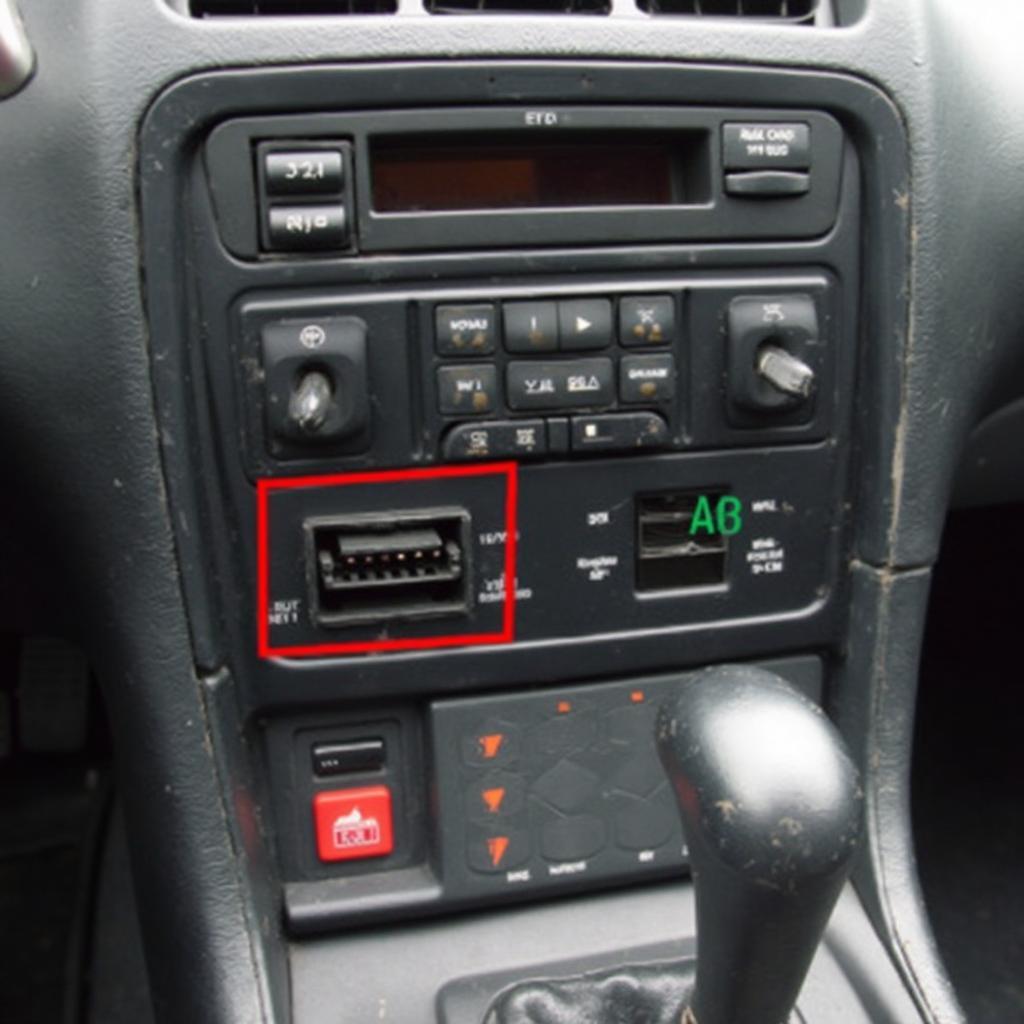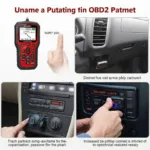The 1994 Mitsubishi 3000GT marks a transition year for onboard diagnostics, raising the question: is it OBD1 or OBD2? Understanding this is crucial for proper diagnostics and maintenance. This article will delve into the specifics of the 1994 3000GT’s diagnostic system, providing clear guidance on identifying whether your car is OBD1 or OBD2 compliant.
Determining Your 1994 3000GT’s OBD System
Pinpointing the correct diagnostic system for your 1994 3000GT requires looking at a few key factors. While 1996 was the mandated year for all cars sold in the US to be OBD2 compliant, some manufacturers, including Mitsubishi, started implementing OBD2 systems earlier. This means certain 1994 3000GT models could indeed have OBD2, while others retain the older OBD1 system.
Checking the Underhood Emissions Label
The most reliable way to determine your 1994 3000GT’s OBD system is to check the underhood emissions label. This sticker, typically located on the underside of the hood or near the radiator, contains vital information about the car’s emissions system, including its OBD compliance. Look for the phrase “OBD II Certified” or similar wording. If present, your car is OBD2. If the label doesn’t mention OBD II, it’s likely an OBD1 system.
Examining the Diagnostic Connector
Another method to identify the OBD system is by inspecting the diagnostic connector. OBD1 connectors vary significantly between manufacturers and even models. They often have a non-standardized shape and location. OBD2 connectors, on the other hand, are standardized with a 16-pin trapezoidal shape, usually located under the dashboard on the driver’s side. Locating a 16-pin connector strongly suggests OBD2 compliance.
Why Knowing Your OBD System Matters
The difference between OBD1 and OBD2 extends beyond the connector shape. OBD2 offers standardized diagnostic trouble codes (DTCs), protocols, and connector location, making it much easier to diagnose issues. OBD1 systems are less standardized, requiring different tools and procedures for each manufacturer. Using the correct scanner is essential for accurate readings and effective troubleshooting.
Choosing the Right OBD Scanner for Your 1994 3000GT
Selecting the appropriate scanner hinges on correctly identifying your car’s OBD system. Using an OBD2 scanner on an OBD1 car, or vice versa, won’t yield useful results. For 1994 3000GT owners unsure about their OBD system, investing in a scanner that supports both OBD1 and OBD2 protocols is a practical solution.
Understanding OBD1 and OBD2 Differences for Your 1994 3000GT
While both systems aim at monitoring emissions and diagnosing issues, they differ significantly in their capabilities and complexity. OBD1 primarily focuses on monitoring the engine’s major components, while OBD2 expands its scope to include other systems like the transmission and emissions control. This wider coverage allows for more comprehensive diagnostics and better emission control.
Key Differences Between OBD1 and OBD2
-
Diagnostic Trouble Codes (DTCs): OBD2 utilizes standardized five-digit alphanumeric codes, providing more detailed information about the fault. OBD1 codes are less standardized and vary between manufacturers.
-
Data Stream: OBD2 provides real-time data from various sensors, allowing for a more dynamic view of the engine’s performance. OBD1 offers limited data stream capabilities.
-
Self-Diagnostics: OBD2 includes more sophisticated self-diagnostic capabilities, allowing the system to identify a wider range of issues.
-
Emissions Monitoring: OBD2 places a greater emphasis on emissions monitoring and includes specific tests to ensure compliance with emissions regulations.
“Knowing the specific OBD system of your 1994 3000GT is paramount for accurate diagnosis. Using the wrong tools can lead to frustration and inaccurate readings,” says James Miller, Senior Automotive Diagnostic Technician at Miller’s Auto Repair. “Always double-check the underhood emissions label for confirmation.”
Troubleshooting Common Issues with a 1994 3000GT
Regardless of whether your 1994 3000GT uses OBD1 or OBD2, understanding how to troubleshoot common problems is essential. Some frequent issues include check engine light illumination, rough idling, and performance problems. A proper diagnostic scan can pinpoint the source of these issues, saving time and money on repairs.
Conclusion: Ensuring Accurate Diagnosis for Your 1994 3000GT
Accurately identifying whether your 1994 3000GT is OBD1 or OBD2 is the first step towards effective diagnostics and maintenance. By checking the underhood emissions label and the diagnostic connector, you can confidently choose the correct OBD scanner and troubleshoot any issues efficiently. This knowledge empowers you to maintain your 1994 3000GT and ensure optimal performance.
FAQ
-
What is the difference between OBD1 and OBD2? OBD2 is a more advanced system with standardized codes and enhanced diagnostic capabilities. OBD1 systems are less standardized and vary between manufacturers.
-
Where is the OBD connector located on a 1994 3000GT? The OBD2 connector is typically located under the dashboard on the driver’s side. OBD1 connectors vary in location.
-
Why is my check engine light on? Numerous issues can trigger the check engine light. An OBD scanner can retrieve the specific diagnostic trouble code to pinpoint the problem.
-
Can I use an OBD2 scanner on an OBD1 car? No, you need a scanner compatible with the specific OBD system of your car.
-
What should I do if I’m unsure about my 1994 3000GT’s OBD system? Consult the underhood emissions label or invest in a scanner that supports both OBD1 and OBD2 protocols.
-
Where can I find more information about OBD systems? OBDFree offers a wealth of information and resources on OBD scanners and diagnostic systems.
-
What are some common problems with the 1994 3000GT? Some common issues include check engine light illumination, rough idling, and performance problems.
For assistance, contact us via WhatsApp: +1(641)206-8880, Email: [email protected] or visit us at 789 Elm Street, San Francisco, CA 94102, USA. Our customer service team is available 24/7.

